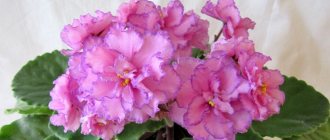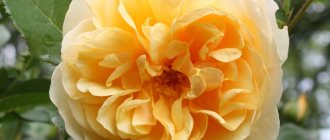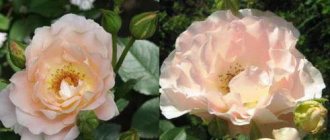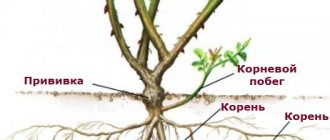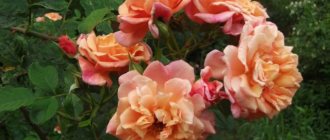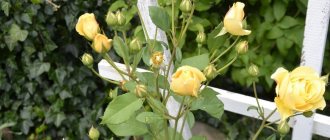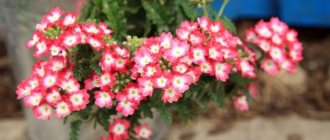History of selection
Translated from English, “Blue Moon” means “Blue Moon”. The plant received this name for the unusual cold lilac or blue tint of the petals of the buds. The Blue Moon rose variety was bred in the second half of the twentieth century (1964) by Tantau plant breeders. It was a bush hybrid tea rose, which quickly gained popularity among gardeners.
Ten years later, scientists discovered a random bud mutation that gave the flowering plant the property of climbing. Biologists call this phenomenon “climbing,” which translated from English means “to rise,” “to climb.” An accidental discovery gave rise to the creation of a new species - the Blue Moon climbing rose. Its originators were the Australian Julie Jackson and the American Fred A. Mungia.
Blue Moon has been awarded two gold awards at international flower shows. This flower received a test certificate at the Bageigne competition, which was held in Paris.
The climbing variety Blue Moon was developed in the second half of the last century
Description of climbing rose Blue Moon and characteristics
The climbing rose Blue Moon is a vigorous, spreading plant, the height of the stems can reach 3 m, and in regions with a warm climate, 4 m. The width of the bush is 70-80 cm. The dense and strong shoots of the Blue Moon have practically no thorns. The color of the stems is dark green.
The blue climbing rose Blue Moon is characterized by the presence of complex leaves, each of which consists of several simple, rounded, elongated and slightly bent outward leaf blades. The leaves are matte, dark green. The edge of the leaf blade is serrated. The foliage of the stems is intense.
Rose Blue Moon is a repeat-blooming plant, that is, flowering occurs twice a season with a short break. The flowering period of Blue Moon is quite long - the first buds appear in early summer, and the last in mid-autumn. With proper care, the interval between the first and second flowering can be practically unnoticeable. As a result, it seems that the plant blooms continuously.
Unopened Blue Moon buds are usually purple in color. When they open, they turn into large flowers, about 12 cm in diameter, with blue, purple or light lilac buds. Each flower basket consists of 25-30 petals, the shade of which depends on the location of the plant: in the shade they are lilac, and in the sun they are rich blue. The buds can be single or collected in small inflorescences of 3-5 pieces. During the flowering process, the shape of the flower basket changes. At first it is a conical bud, and then goblet-shaped.
The flowers have a pleasant, subtle aroma of rose oil with subtle citrus notes. It is noteworthy that the smell emitted by the flowers of the rose bush persists throughout the entire flowering period of Blue Moon.
After flowering ends, false fruits of a rounded-elongated shape with small seeds are formed on the receptacle. The seed material is suitable for propagating the Blue Moon rose, but it is used extremely rarely for this purpose.
Blue Moon is a heat-loving plant, so a drop in temperature below -20 °C can be disastrous for it. In the Russian Federation, the climbing rose Blue Moon feels good in the southern regions, but flower growers in central Russia who want to have this whimsical beauty in their garden will have to work hard.
Attention! Blue Moon is also grown in regions with cool climates. The main thing is to choose a sunny place for it and cover it well for the winter.
For a climbing rose you will have to build a support
Differences between Blue Moon and Blue Girl roses
In terms of external features, the climbing rose Blue Moon, as seen in the photo, is somewhat similar to Blue Girl.
Blue Girl and Blue Moon are highly decorative
Both plants are repeat bloomers and have a long flowering period. However, there are significant differences between them.
| Blue Moon | Blue Girl | |
| Plant type | Rose hybrid tea climbing | Hybrid tea rose bush |
| Stems | Strong curly, 350-400 cm high | Powerful, erect, 60-70 cm high |
| Leaves | Matte dark green | Semi-gloss dark green |
| Flowers | Goblet-shaped, located singly or in groups of 3-5 pieces. The flower basket is goblet-shaped, consists of 20-25 petals of a blue or lilac hue | More luxuriant than that of the Blue Moon, the double flowers are arranged singly. A terry flower basket is formed by about 40 lavender petals |
Decorative advantages of the best “blue” rose
Hybrid tea rose “Blue River” belongs to the group of so-called blue roses. Naturally, they are called “blue” only conditionally. This group includes all varieties of roses with the coolest purple and lilac colors, bred through long-term selection. However, these roses are united not only by a cold palette, but also by an extraordinary, easily recognizable aroma, which differs from all other garden princesses.
“Blue River” is a cut rose and very fragrant, retaining its aroma even after the inflorescences dry, lasts a long time in bouquets and is perfect for floristry. Being the most spectacular and relatively hardy variety compared to other blue roses, “Blue River” can boast a long flowering period, the beauty and size of individual flowers, which seem simply huge on fairly modest bushes.
This variety of roses was bred only in 1984. One of the most beautiful lilac hybrid teas was obtained on the basis of several large varieties and inherited its color from the famous Mainzer Fastnacht rose.
Silhouette and foliage
The “Blue River” rose reaches a height of about 80 cm. It is a compact, upwardly growing rose that practically does not gain volume and does not grow in width. All its shoots are directed vertically and branch mainly in the upper part.
Rose "Blue River" baumschule-horstmann
The lack of a lush and attractive crown, and often completely bare shoots, is the main drawback of the Blue River. The lower part of the bushes is never leafy, and in unfavorable conditions or with careless care, this rose can even shed a large number of leaves in the middle of the season, which creates a feeling of neglect. That is why “Blue River” requires planting at the foot of plants that would camouflage the base of the bush and partially compensate for this deficiency.
Despite the fact that there are few leaves, they are quite attractive. Glossy, dark, large, with light veins, they are ideally proportional to the petals of the flowers.
Flowering time
The “Blue River” blooms from June until the onset of the very first frosts. The rose produces huge flowers during the first months of flowering, and then their size and color change slightly.
Features of flowering
Even the buds of this rose are charming. Oval, quite wide, with a sharp apex, they gradually bloom into huge flowers up to 9 cm in diameter with almost perfect petals with a smooth edge and a soft color transition. Densely double, classically symmetrical flowers most often bloom one at a time on the shoots, but sometimes 2-3 flowers bloom on powerful peduncles on one stem.
Color spectrum
Of all the blue roses, the “Blue River” palette looks most impressive in garden compositions. The flowers of this variety are not afraid of rain and remain on the bushes for a very long time.
They are colored in a cool lilac shade with a play of color between the center and the edges of the flower. The pale lavender color of the central petals is amazingly emphasized by the crimson border along the edge of the outer circles of the petals, creating a kind of halo around the calyx of the flower. From a close distance, it seems that the inner petals seem to be lightly sprinkled with white powder. As the rose blooms, silver-gray, blue and lilac shades gradually replace each other, and the rose acquires an increasingly bright color. Having reached their greatest color, the flowers of the “Blue River” begin to fade. Roses become more and more pink, losing their characteristic coolness of color.
The color tone of the flowers directly depends on the characteristics of the soil in which Blue River grows. On comfortable soils, the lightest petals on a rose actually seem almost blue-gray; on poorer soils, they take on a rich pink tint.
Advantages and disadvantages of the variety
Rose Blue Moon has many advantages. However, it also has disadvantages.
One of the advantages of the Blue Moon rose is its unusual color.
Pros:
- highly decorative;
- pleasant aroma;
- almost complete absence of thorns;
- re-blooming.
Minuses:
- poor frost resistance, which necessitates serious protection from winter cold;
- weak immunity to diseases;
- the need to construct supporting supports.
Reproduction methods
There are three ways to propagate climbing roses:
- By cuttings. Cut cuttings of approximately 12 cm, treat the cuts with a preparation for rapid rooting (Kornevin) and plant them in moist soil under a glass jar.
- By layering. After flowering ends, one of the stems is buried. When the cuttings take root, they are transplanted to a new place.
- Dividing the bush. Dig up a bush and use a sharp knife to divide the root system into several parts. The resulting divisions are transplanted to a new location.
Attention! Each cutting should have three buds, and each cutting should have at least two viable shoots.
Greenhouse conditions are required for rooting cuttings
Landing
To plant wisteria in open ground, it is advisable to choose 2-year-old seedlings. In this case, they will cope with adaptation more easily. The frost-resistant variety is unpretentious to soils. The main thing is that it is not peat soil. Drained, slightly alkaline soil mixed with humus is considered ideal for planting. However, other types of soil are also suitable for planting.
Important: if the soil is very sandy, abundant watering will be required in summer!
Planting in open ground:
Dig a hole. Its depth should not be less than 25 cm. Place humus at the bottom of the hole
You can also add sand, rotted leaves or clay-turf soil. When planting, you should pay attention to ensure that the neck of the root is not lowered into the soil. Water the wisteria daily.
In order for the planted plant to quickly begin to develop its root system, dry grass can be spread around it. It will absorb moisture, which will help the flower take root faster.
Its flowering and survival rate depend on the location of wisteria. Gardeners advise planting wisteria in an area well lit by the sun. If there is a brick wall in the garden, it is advisable to plant the plant near it. The brick accumulates solar heat and warms the perennial.
How the summer goes for wisteria determines how it will survive the winter. Therefore, the more heat it receives during the warm season, the better.
Please note that the flower needs to be exposed to sunlight for at least 6 hours a day. Well, flowering will occur when daylight hours last for at least 12 hours.
Important: Wisteria does not tolerate drafts and cold winds. Therefore, on one side it should be separated by a wall
The best option would be to plant on the south side of the garden.
For a stable position, the vine must wrap around the support. The material for support can be any. The main thing is size. The support must be strong and large to support the weight of the vine.
Growing and care
For a rose, a place in the open sun or in lace shade is suitable. The optimal time for planting is considered to be the second half of May.
Landing
The planting material is kept in water for several hours. This allows the roots to expand and also absorb moisture.
The landing algorithm is as follows:
- the selected area is dug up, a hole of the required size is made and drainage is laid;
- the seedling is placed in the middle of the hole, the roots are straightened;
- cover the shoot with soil, deepening the neck by 2-3 cm;
- the soil is compacted, watered and covered with mulch.
Advice! Excess moisture can cause rotting of the root system, so it is better to plant the rose in a place where water will not accumulate in the spring, as well as during the rainy season.
Care
The Blue Moon rose variety cannot be called an unpretentious plant. In order for it to grow normally and delight with lush flowers, it needs to be provided with proper care:
- regular but not excessive watering, the frequency of which depends on weather conditions;
- loosening, which should be carried out after each watering, and removal of weeds;
- fertilizing, which is done 5-6 times during the entire growing season of roses using special complex fertilizers for roses;
- pruning - in the first year, damaged areas of vines and weak shoots are removed, in the second and subsequent years, side shoots on the main lashes are cut by ½, and old stems are also removed.
Attention! If you leave old shoots that do not throw out buds, the decorative value of the Blue Moon rose will decrease over time.
Rose needs moderate watering
How to plant correctly?
Climbing rose “sympathy”: description of the variety, features of planting and care
To grow a bonsai from wisteria, it can be planted in several ways. Let's describe each of them.
Horizontal layering
- They choose a long shoot from last year and dig a trench under it.
- Fill the hole with nutritious soil and moisten it abundantly.
- A shoot with cut buds is placed in the trench, which is then secured to the ground - metal pins are suitable for this.
- After this, they are covered with soil, leaving only the top. Root shoots will grow from leaf buds.
By cuttings
- In the autumn, the mother shoot is cut off.
- Then it is cut into cuttings so that a bud remains on each of them.
- The cuttings are planted in small containers and placed in a dark place until spring.
- At the beginning of spring, the sprouted cuttings are planted in a permanent place.
Seeds
- The seeds are placed in a gauze cloth and dipped in water to soak until they hatch.
- After this, the seeds are planted in moist soil.
- A high-quality substrate consists of three components: three parts of leaf soil, 1 part of leaf soil and 1 part of river sand.
- Be sure to take care of the drainage layer - brick chips or expanded clay are suitable.
- The seeds are placed in the substrate to a depth of 1 cm.
- Cover the container with film or glass and move it to a dark place at a temperature of 20-24 degrees.
To grow a tree from wisteria, you need to follow the following recommendations:
- Install a support near the future tree, the thickness of which should be at least 5 cm, and the height should be approximately 2-2.5 meters.
- At the top of the support, build a frame that looks like an umbrella.
- The first year, wisteria grows freely. Prune in spring to stimulate side shoots.
- Twist all subsequent shoots in one direction and distribute them over the umbrella.
- Every year, cut the shoots by 2 buds, giving the tree a spherical shape.
We invite you to watch a video on how to grow wisteria from seeds:
Application in landscape design
The high decorative value of the Blue Moon makes it possible to use it in landscape design to decorate fences, walls, open terraces and gazebos. Arches, pergolas and columns entwined with blue and lilac roses can become one of the main attractions of any site. A climbing rose fixed on supports stands out against the green lawn.
Good neighbors for Blue Moon will be clematis and conifers (cypress, thuja, blue spruce, juniper). In front of the bush you can plant low-growing flowering plants - asters, lavender, sage, bluebells.
A climbing rose is planted at the entrance to the house
